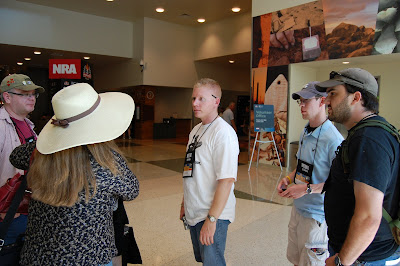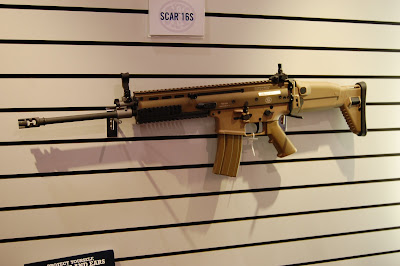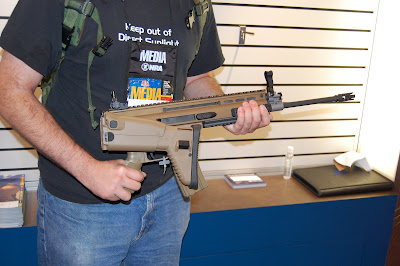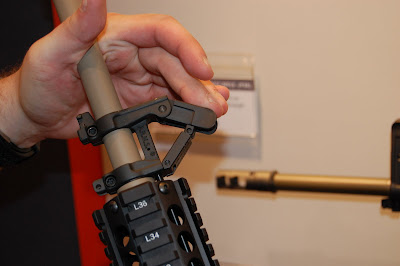Saturday night consisted of reviewing some of my notes from the day and getting ready for Sunday.
On Sunday, I decided to be a bit adventuresome and take the metro light rail train into downtown Phoenix, so as to avoid the high parking fees. After getting horribly lost (which included driving through a shady looking trailer park whilst looking for parking — they need better signs) for a short period, Louis and I arrived at the train station, parked, and were off to the convention center.
Once there, we met up with a few other bloggers at the NRA Press Office and went out to lunch. Going off memory, we had Sebastian and Bitter, Eric, Mike, Bradford, and a couple other folks who I seem to have forgotten (sorry guys!).

From left to right, we have Sebastian, Bitter, Eric, Mike, and myself.
After experiencing the silliness of Arizona gun laws relating to carrying in establishments that serve alcohol, we had a tasty lunch, and most of us (Jason was going back to the airport) headed back to the show.
I really wanted to ask the Ruger reps some questions about the SR-556, but they were quite busy when I first checked, so Louis and I perused the exhibit floor and managed to get our hands on some things that we didn’t get to see the previous day, including the FN SCAR:

The SCAR had some different ergonomics than the AR platform (which I’m used to), but still seemed to be reasonably lefty friendly. One notable feature was the folding stock — a simple button-press released the stock, which folded around to the right. It snapped into a notch on the brass deflector and so could be secured in the folded position. The stock didn’t end up blocking the ejection port when folded, and since no operating parts were in the stock the gun could be fired while folded. Very cool.

One booth was run by a few skilled craftsmen who made very tiny, functional pistols. The gentleman (whose name I can’t recall) from the Pennsylvania Firearm Owner’s Association who was walking around with us mentioned that on Saturday the booth had a tiny, fully working 1911 that fired itty-bitty cartridges, but that exhibitor was not present today. That would have been really interesting to see.
Finally, I saw a break at the Ruger booth and struck. Fortunately, my questions were not terribly time-consuming, and I got most of them answered in just a few minutes.
Moving on, we found some very cool rifles at the Bushmaster booth — I’m very familiar with the solid, triangular front sight post on AR-pattern rifles, and I’ve seen and used various flip-up iron sights, but I’ve never seen the two combined into a flip-up, triangular front sight post:

This sight was remarkably rigid when extended and was quite compact when folded. The only problem I could see was that there wasn’t any sort of detent that would keep the sight folded — if one were to bump or brush the front sight against something, it’s possible that the sight could flip back up. There wasn’t a detent to lower the sight, but it required force applied in a specific manner, so I don’t think it’d be likely to fold down on its own. This particular front sight post also included a bayonet lug, though they have models without the lug if one wishes.
One can buy such a front sight assembly from the manufacturer here.
The .410 Shotshell/.45 Colt Taurus Judge revolver is an impressive beast, yet still fit comfortably in my hand. I’d really like to give this revolver a spin at the range sometime.
The Glock booth was near the Taurus booth, so we handled a few of the 4th Generation pistols and spoke with some of the reps.
Louis and I then went and lusted over the shinies at the CZ booth, where I was happy to learn that I could order a left-handed CZ-452 American direct from CZ, have their custom shop replace the ordinary barrel with the 16″ pre-threaded barrel found on this model, and have it sent directly to my FFL for pickup. Basically, I’d have a lefty, 16″, pre-threaded 452. Since I love shooting my .22s suppressed and have ammo that’s just barely subsonic out of a 16″ barrel, this is excellent news indeed. They gave me a card and asked me to call in the next week or so to work out a price.
We then headed over to the Leupold booth, where we got to play with their scopes. Compared to the other optics available at the show, the Leupold ones were far and away the brighter and clearer. Louis is an astronomer, and so has developed a great eye for optical aberrations and flaws…and found none in the Leupold optics, while detecting a few minor things (mostly chromatic aberration) in scopes from other brands like Nikon.
While their scopes are made in the US, I was a bit dismayed to discover their laser rangefinders are made in China. Even so, the different models were extremely consistent when ranging to the same object (the far wall of the exhibit hall), and were within one yard of each other. Several of the models took into account the elevation angle, showing both the actual range and the range that one should set one’s sights at when shooting at that angle. Very neat.
A few of the Leupold scopes also had illuminated reticles, and several of those went to eleven (( From This is Spinal Tap. )).
After Leupold, we briefly stopped by the Dillon booth and ogled their progressive presses. Alas, while we were doing so, 5:00pm rolled around, and an announcement was made that the annual meeting was over, and would people please make their way to the exits.
In conclusion, while I didn’t get to see any of the various meetings and presentations made by the NRA (with the exception of the one on Jeff Cooper, who was a truly amazing man), I did get to meet with several of the vendor reps, get some information about new products they were offering, handle many of their products, met with a bunch of gunbloggers, and generally had a great time.
I’m not sure if I’ll be able to make next year’s annual meeting and Blog Bash, but I’ll definitely make an effort to do so.